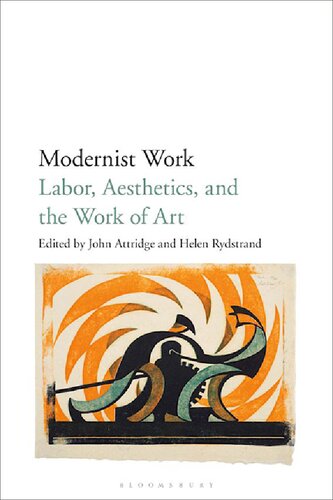
Modernist Work: Labor, Aesthetics, and the Work of Art PDF
233 Pages·2019·6.059 MB·English
Most books are stored in the elastic cloud where traffic is expensive. For this reason, we have a limit on daily download.
Preview Modernist Work: Labor, Aesthetics, and the Work of Art
Description:
Through a wide-ranging selection of essays representing a variety of different media, national contexts and critical approaches, this volume provides a broad overview of the idea of work in modernism, considered in its aesthetic, theoretical, historical and political dimensions.Several individual chapters discuss canonical figures, including Richard Strauss, Joseph Conrad, Virginia Woolf, Franz Kafka and Gertrude Stein, but Modernist Work also addresses contexts that are chronologically and geographically foreign to the main stream of modernist studies, such as Swedish proletarian writing, Haitian nationalism and South African inheritors of Dada. Prominent historical themes include the ideas of class, revolution and the changing nature of women’s work, while more conceptual chapters explore topics including autonomy, inheritance, intention, failure and intimacy.Modernist Work investigates an important but relatively neglected topic in modernist studies, demonstrating the central relevance of the concept of “work” to a diverse selection of writers and artists and opening up pathways for future research.This collection posits that “work” is a modernist keyword. In the phrase “work of art”, it designates one of modernism’s most urgently debated aesthetic and ontological questions, calling to mind such themes as the artwork’s autonomy or its status in an age of mechanical reproduction. As the name of a process, “work” denotes another, closely related subject of modernist inquiry, to do with the social identity of the artist and the vexed status of artistic production in a period of accelerating industrialization. “Work”, finally, is a modernist keyword because the transformation of the Arbeitswelt was one of the modernist period’s most significant vectors of historical change. Through a wide-ranging selection of essays representing a variety of different media, national contexts, and critical approaches, this collection provides a broad overview of the idea of work in modernism, considered in its historical, political, aesthetic, and theoretical dimensions.
See more
The list of books you might like
Most books are stored in the elastic cloud where traffic is expensive. For this reason, we have a limit on daily download.
